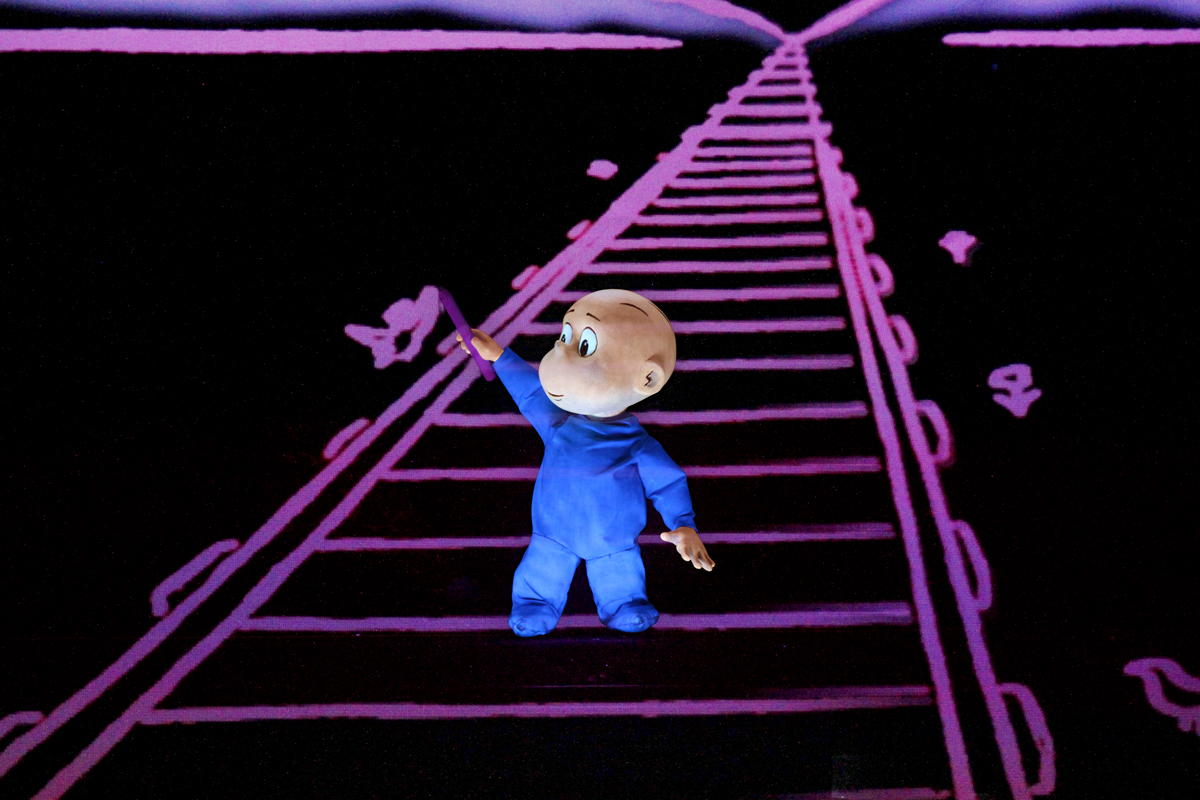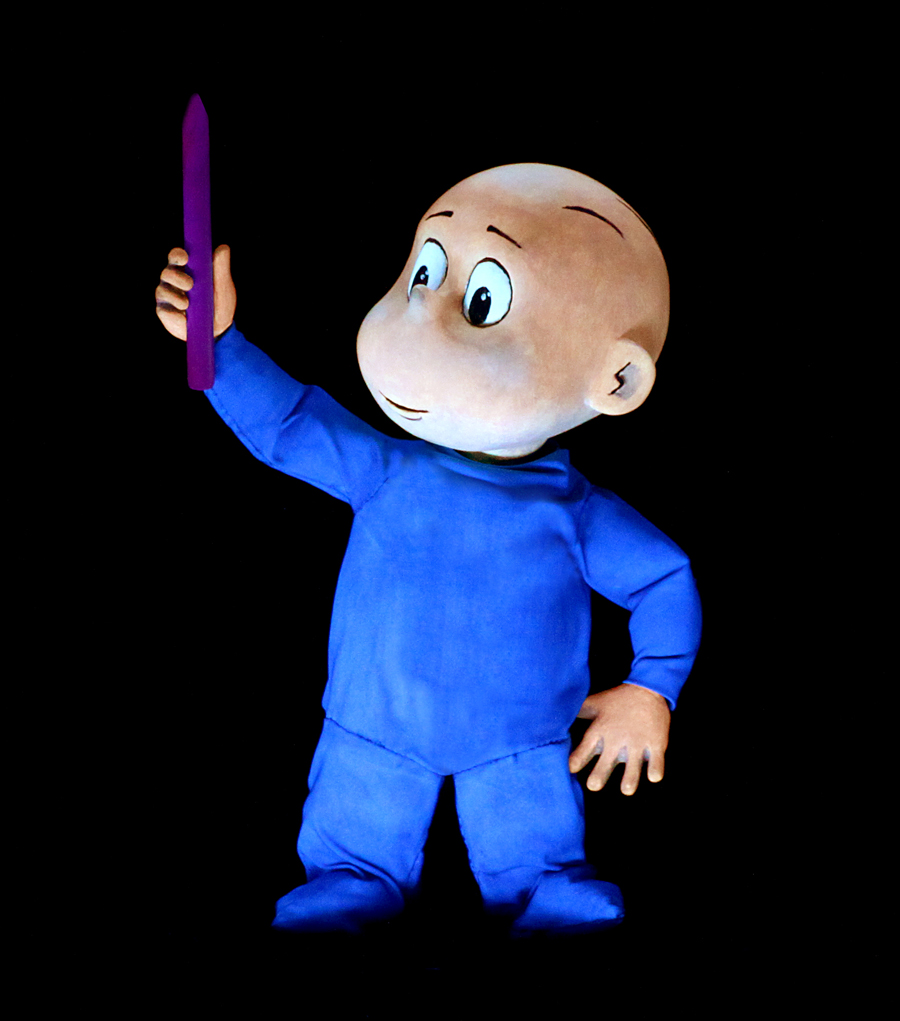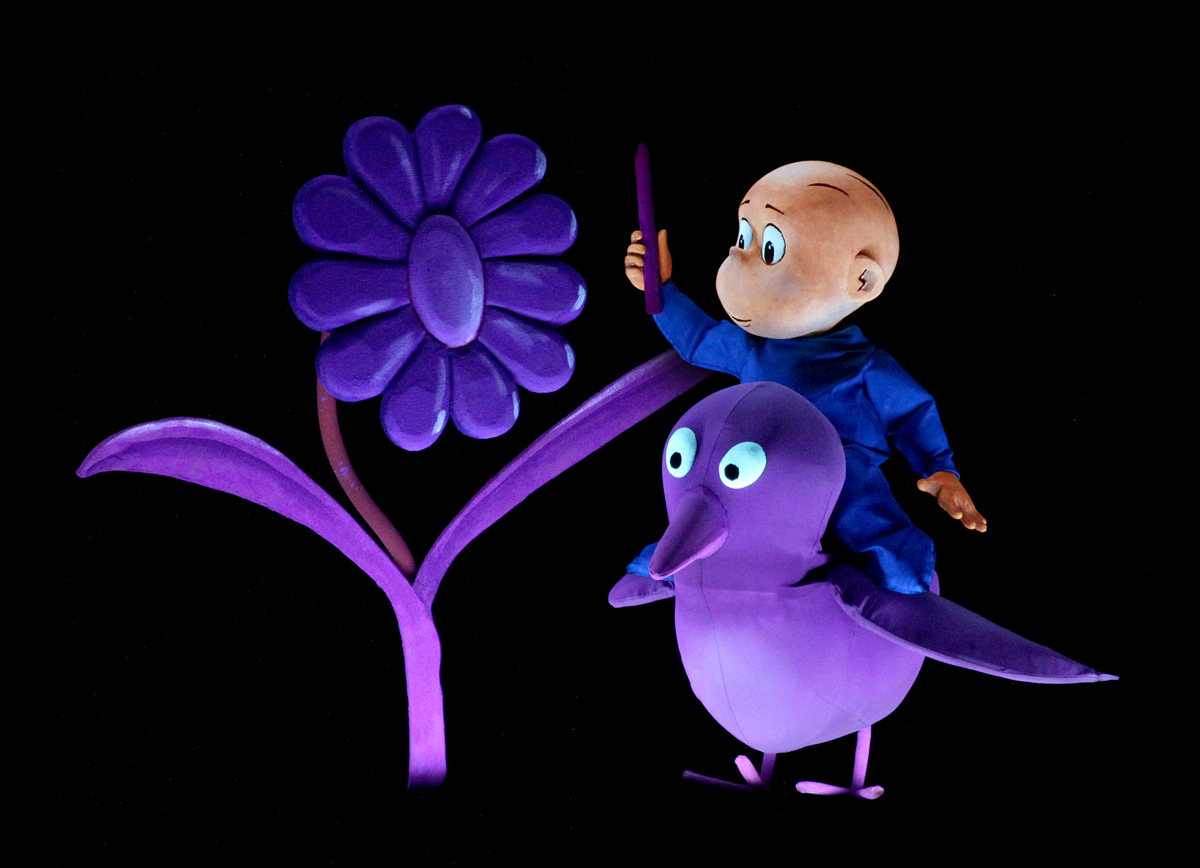
Photograph courtesy of the Center for Puppetry Arts
The Center for Puppetry Arts’s inaugural production of Harold and the Purple Crayon will feel very familiar to anyone who’s read the classic children’s series by Crockett Johnson, the first of which was published in 1955. Little Harold struggles to fall asleep one night and grabs his trusty purple crayon, drawing fantastical worlds and creatures that magically come to life. What will be new is just how real Harold and his world become through the Center’s use of puppets, blacklights, and a 19th-century illusion technique that has added drama to acts from Disneyland to Coachella.
In the new production, Harold is a puppet, as are most of the creatures he brings to life. And his drawings become animated—with train tracks running beneath his feet, a boat floating by, and stars racing all around as Harold takes off on his (puppet) rocket ship. These effects are possible through carefully coordinated animation and an illusion technique known as Pepper’s Ghost. Created in the mid-1800s, Pepper’s Ghost uses projections and reflective surfaces to create illusory figures that seem to appear out of thin air. The technique was used in sideshows during the Victorian era and, in the 1960s, created ghosts in Disneyland’s Haunted Mansion. In 2012, Coachella used it to create a “hologram” of the late Tupac Shakur performing on stage. (Actually, Pepper’s Ghost projections are not holograms, which are instead created with lasers.)

Photograph courtesy of the Center for Puppetry Arts
While the Pepper’s Ghost technique initially involved reflecting images onto large panels of glass, the Center uses a more modern method. A thin, highly reflective transparent sheet—essentially invisible to the naked eye—is stretched in front of the stage at a 45-degree angle. Two projectors direct animations onto a screen, which is then reflected by the sheet. The stage is lit only by blacklights, which makes the puppets, painted in UV-reactive paint, and the animation stand out while completely obscuring the puppeteers, who are dressed head-to-toe in black.

Photograph courtesy of the Center for Puppetry Arts
The UV-reactive paint posed a few challenges for resident puppet builder Jason Hines. For one, he had to paint all of the puppets in a windowless, blacklight-lit room in order to make sure the colors and details would appear correctly. But the biggest difficulty was the color of Harold’s signature crayon.
“Purple is the worst color,” Hines says. “Reds, yellows, and oranges are really bright [under a blacklight], but blues and purples just aren’t. So I mixed lots of different tones and shades and incorporated a lot of highlight and shadow.” He also used magenta to add contrasting details—such as on the antlers of a moose and spines of a porcupine. “We just explored every variation of purple that we could.”
Another major challenge was that, while the audience can see the vivid projections, the actors backstage cannot. This made hitting performance marks—such as having Harold’s puppet crayon line up with the animated line being drawn from it—virtually impossible. The team developed an innovative solution: a third projector on the floor projects a camera feed to a video screen. That videos screen is then reflected in front of where the puppeteers perform, serving almost like a “teleprompter.”

Photograph courtesy of the Center for Puppetry Arts
Hines and artistic director Jon Ludwig began working on Harold and the Purple Crayon a year and a half ago, adapting five of the Harold stories into an hour-long show. They aimed to stay true to the source material, using narration from the pages and keeping the look similar to the original illustrations. “There are versions out there for live actors, but they kind of stray from [the original book],” Ludwig says. “This really is the book. We just embellish it.”
One of those embellishments came in the forms of the Very Hungry Moose and the Deserving Porcupine, two critters that Harold draws in the books but who take on a much larger roles as comical sidekicks in the Center’s version. “They were such cute puppets that I knew they had to follow Harold around,” Ludwig says. “In the book, he just creates them, leaves, and you never see them again. And I thought, wow, what a waste of a puppet. So they tag along with Harold—they even go into space with him.”

Photograph courtesy of the Center for Puppetry Arts
An original score by Dolph Amick adds personality to some of the characters. For example, a whale is accompanied by a “gentle song with a sailor’s hornpipe,” says Ludwig. He adds that the creativity of Harold’s imagination and the crayon drawings naturally lend themselves to puppetry.
“Harold’s creating his own world, which is very similar to what puppetry does,” Hines says. “So it’s kind of like Harold is puppeteering his own world.”
See the show: Harold and the Purple Crayon runs through May 26 at the Center for Puppetry Arts in Midtown. Tickets are $25 each and include the “Create-a-Puppet Workshop” where kids can make their own “Magnificent Mouse” tabletop puppet. A sensory-friendly performance will be held on April 14.













